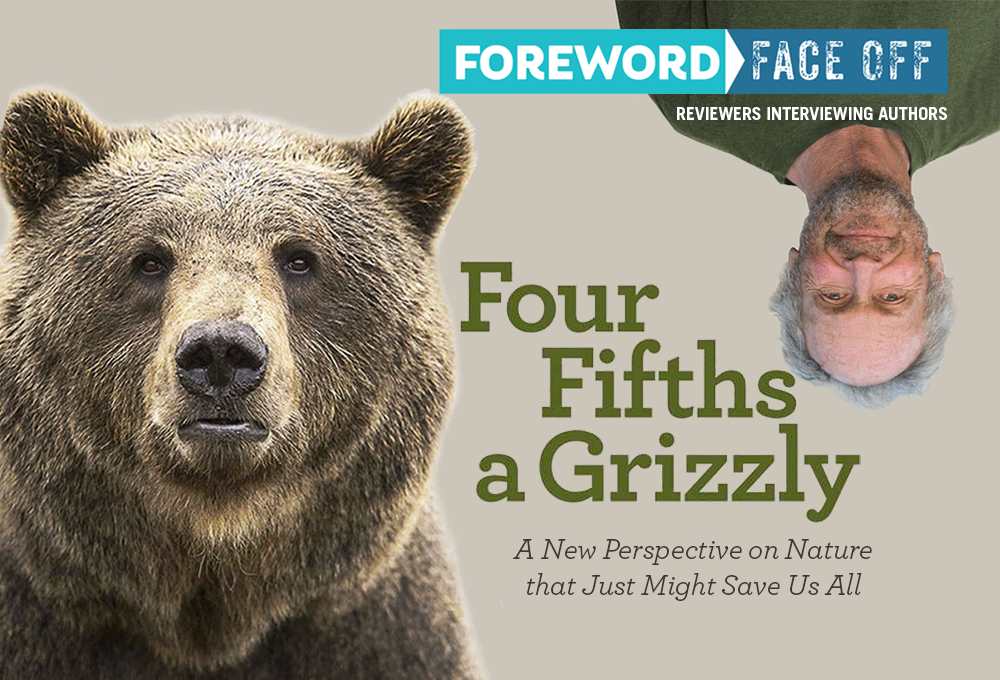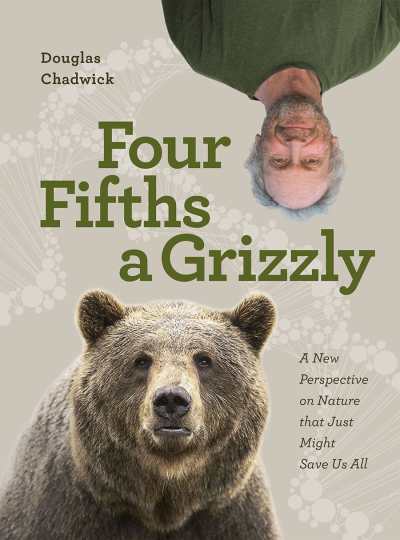Reviewer Rebecca Foster Interviews Douglas Chadwick, Author of Four-Fifths a Grizzly

The headlines aren’t pretty right now: Afghanistan. Delta variant. Earthquakes. Wildfires. Heat waves. Hurricanes. Makes you want to descend into a gloomy little cloud of hopelessness, right?
Don’t let it happen. Instead, let yourself fixate on some of the positive things happening in the world, as recommended by this week’s guest, Douglas Chadwick, author of the newly released Four-Fifths a Grizzly and several other nature/wildlife books over many years. Not that Douglas wants you to put blinders on about the human condition.

Here’s the buoyant thought he ends the following interview with Rebecca Foster, who reviewed Four-Fifths a Grizzly in Foreword’s July/August issue—“We’re a wonderful species, imaginative, creative, exploratory, and filled with boundless promise. We can do anything if we put our minds and heart into it. Now is the time for an updated golden rule: Do unto ecosystems as you would have them do unto you: nurture, sustain health, allow to flourish.”
Enjoy the conversation!
What is it about grizzlies that captured your imagination? (As opposed to, say, 99 Percent a Chimp.)
I would ask, “What is it about grizzlies that doesn’t capture people’s imaginations?” They are big, fast, fierce, and incredibly powerful. They are also curious, playful, and highly intelligent, and I learned from hundreds of hours spent watching them in Alaska and here in Montana’s Rockies how curious and playful they can be as well. Although many people understand that we are closely related to chimpanzees and other great apes, I don’t think many realize that these indomitably wild bears are close kin too. So are the great whales, little field mice, giraffes, snow leopards, bats, the household dog at your feet, or the cat on your lap.
At least 80 percent of the genes we humans carry are identical to those of virtually every other mammal on the planet. For that matter, we share more than half our genes with fish, more than 40 percent with some insects, 20 to 30 percent with plants, 18 percent with baker’s yeast, and so on. The fact that every living creature is part of our extended family doesn’t diminish our stature as humans. On the contrary, it makes us more than just human. In our connections to nature we discover our greater self.
The message of your book might be summed up as—to borrow an out-of-context phrase from E.M. Forster—“Only connect.” What are some ways that we can awaken to that knowledge of our connection with other species?
After considering the genes you share with the rest of life on Earth, have a look into your microbiome—the trillions of bacteria, archaea, protozoans, and single-celled fungi that outnumber the human cells on and in your body. Then have a peek inside each of your 30 trillion human cells. There, you’ll find the miniscule organelles called mitochondria that power whatever any plant or animal does: move, grow, reproduce, counter disease, etc. Everything! Mitochondria are the cells’ batteries, providing the spark of life. Only bacteria, archaea, and a few other types of microbes exist without them. The mitochondria themselves are modified ancient bacteria that live in symbiosis—a mutually beneficial combination with us. You may not think of yourself as being especially into nature. But nature is totally into you. If you prefer to think of yourself as an independent individual, fine. The reality is still that you are intimately partnered with a spectacularly varied array of other organisms, most of which are invisible. That, too, makes you more than human. That, too, is part of what defines your greater self.
Your narrative fuses research and experience. To what extent can books convince people of their interdependence with nature? How much can only come across through getting out there in person?
There is no substitute for getting out and immersing your body and senses in natural settings. Study after study has revealed that even a modest amount of regular contact with nature, whether in untamed green expanses or a little garden spot, boosts humans’ physical health and longevity. This is one of the most remarkable research findings of the past few decades. Surprisingly, the results have not made it very far beyond the scientific literature into the public’s awareness. To better understand how and why the presence of nature causes an automatic improvement in human wellness and mental balance, I spent a whack of time digging into technical journals. Then I had to figure out how to condense that information and try to weave it into stories that most everyone can relate to.
In your storytelling you achieve a remarkable balance between the microscopic and the big picture. Why was it important to you to convey that sense of different scales, and why do both the tiny and the majestic matter?
The answer here is: because the welfare and future survival of the majestic is inextricably tied to the minuscule. Life forms invisible to the naked eye pervade the soils and waters and drift in hordes through the very air, recycling organic compounds, manufacturing new nutrients, taking part in the formation of raindrops … building the richness of this living planet. They make this a literal biosphere. For example, the largest tree towering hundreds of feet high is far from simply being an impressive example of vegetation. It is a compound creature—a collection of organisms in symbiosis with one another: a species of plant; modified cyanobacteria, better known as chloroplasts, which perform the tree’s photosynthesis; modified bacteria—the mitochondria in each plant cell—powering the tree’s metabolism; and hundreds or even thousands of miles of invisibly fine fungal threads tied to the plant’s roots, delivering water and nutrients to the tree from an area ten times as large as the roots themselves can reach and at the same time exchanging nutrients—and chemical messages—with other underground fungal networks and other plants.
The big and the small aren’t separated in ecosystems, and they aren’t separated in what we think of as particular plants or animals. Nature blends them together in almost every case, so I had to find a way, a language, for doing the same if I was going to describe what plants and animals actually are.
The book is illustrated with many stunning photographs. What was the process for amassing these, and how do you hope they will enrich the narrative?
What can I say here besides the old adage that a picture is worth a thousand words? The text presents nature from a fresh perspective, and I wanted illustrations that did the same. I searched hard for images that weren’t classic “beautiful nature” pictures. The photo editor, Jane Sievert, took that search to levels well beyond my abilities, reaching out to photographers and scientists around the world, sometimes tracking them down at remote research stations, and matched the pictures with passages of text to amplify the subjects I was describing. Christina Speed designed the word and visual combinations page by page and also created elegantly clear graphs and charts that summarize major concepts at a glance.
“Rewilding” is a big buzzword in the UK (where I live), referring to setting aside large areas of land for wildlife and reintroducing species, including predators like wolves and sometimes ancient megafauna. Can you imagine this process of recreating wilderness scenarios being a widespread solution to habitat loss?
“Re-wilding” is an attractive strategy. It certainly holds promise; nature possesses immense restorative powers. The challenge lies in getting people with different backgrounds and interests to agree on just how wild a restored wildlife community should be. There were still grizzlies (European brown bears, which are the same species) in the UK and lions in Greece in the days of early kingdoms. Maybe it’s best to just start in strengthening and diversifying the native flora and fauna a step at a time and discover what’s possible as (one hopes) the values people place on healthy, stable natural environments expand over time. Meanwhile, perhaps the real priority ought to be protecting the intact wild communities that still exist in various parts of the globe with their full natural suite of predators and prey. I’d leave the question of restoring Ice Age megafauna and other extinct forms until we proved ourselves better able to conserve the amazing species still with us today.
I loved that you focused on conservation success stories. What are some new or ongoing projects that excite and inspire you? What gives you hope for the future of human–animal coexistence on the planet?
The large-scale, successful conservation programs I highlighted in the book—island conservation and the Yellowstone to Yukon Conservation Initiative—are both ongoing, adding further proof week after week that we really can save a lot in a hurry. I see more projects designed to safeguard animal populations with large-scale migrations that cross local, regional, and even national borders. We humans are fond of defining and defending our own territories, but saving nature on the scale at which wildlife populations and ecosystems operate requires increasing cooperation between different people, cultures and interest groups. Nature thrives because of all the connections between large, small, and invisibly tiny species. Safeguarding the health and beauty and wonder of this living planet calls for greater connectivity on our part—both between people and between us and the natural communities that sustain us all over the long run.
We grow up with a lot of mental assumptions about humans being somehow separate from and superior to the rest of creation. Advances in science reveal these attitudes to be completely at odds with biological facts. They are merely comfortable old myths that have become obsolete and self-defeating in an era with eight billion humans crowding a finite globe. We’re now changing the soils, the seas, and the very composition of the atmosphere while depleting what’s left of Earth’s natural resources—including a frighteningly large portion of our fellow Earthlings, the spectrum of species that share this sphere. Mind you, this is not to cast blame. We’re a wonderful species, imaginative, creative, exploratory, and filled with boundless promise. We can do anything if we put our minds and heart into it. Now is the time for an updated golden rule: Do unto ecosystems as you would have them do unto you: nurture, sustain health, allow to flourish.
Rebecca Foster
